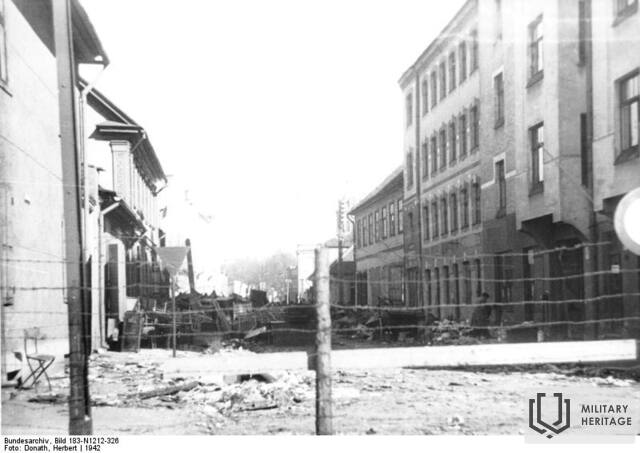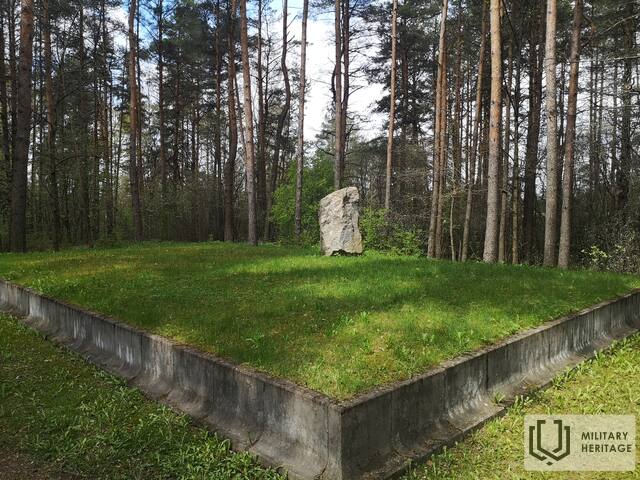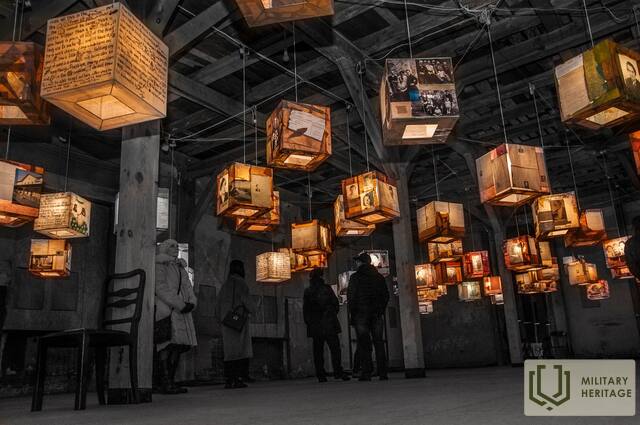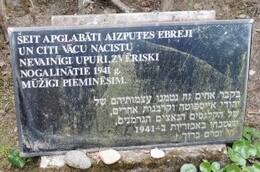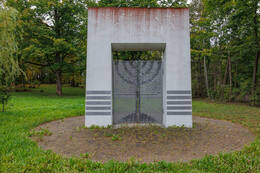Holokaustas II Antrasis pasaulinis karas
Holokaustas (graikiškai: holos – visi, be pėdsakų; kaustos – sudeginti) – masinis žydų naikinimas nacistinėje Vokietijoje ir jos okupuotose teritorijose Antrojo pasaulinio karo metu. Masinio žydų naikinimo procesas prasidėjo okupavus Lenkiją. 1941 m. birželio 22 d., Vokietijai įsiveržus į Sovietų Sąjungą, prasidėjo aktyvioji Holokausto arba Šoa (katastrofos) fazė. Nacių slaptas vadinamasis „Galutinis žydų klausimo sprendimas“ (vok. Endlösung der Judenfrage) numatė visų SSRS teritorijoje gyvenančių žydų nužudymą. Antroje XX a. 4-ojo dešimtmečio pusėje Latvijoje gyveno 93 479 žydai (1935 m.). Dauguma karo metu čia deportuotų Vokietijos, Austrijos, Vengrijos ir Čekoslovakijos žydų taip pat buvo nužudyti Latvijoje. Genocidas taip pat buvo nukreiptas prieš Latvijos romus ir psichikos ligonius. Holokaustas yra didžiausias masinis nusikaltimas, įvykdytas prieš civilius gyventojus Latvijos istorijoje – nacių okupacijos metu žuvo apie 73 000 Latvijos žydų ir 16 000 užsienio žydų.
Holokaustą vokiečių okupuotoje Latvijoje iš pradžių vykdė vokiečių saugumo policija ir SD specialusis dalinys „Einsatzgruppe A“ – didžiausias iš keturių tokių dalinių. Jam vadovavo SS brigados generolas ir policijos generolas majoras Walteris Stahleckeris. Iš pradžių buvo įvesti įvairūs apribojimai ir draudimai, vėliau žydai buvo registruojami ir įpareigoti ant drabužių prisiūti judaizmo simbolį – šešiakampę Dovydo žvaigždę. Žydų turtas buvo konfiskuotas, vėliau izoliuoti ir galiausiai nužudyti. Pirmosios žmogžudystės įvyko 1941 m. birželio 23 d. Gruobinioje. Vokietijos karinė ir civilinė valdžia turėjo įtvirtinti savo valdžią ir įtraukti vietos gyventojus į žmogžudystes. Jos vyko visose gyvenvietėse, kuriose buvo bent nedidelis skaičius žydų. Pagrindiniai žmogžudysčių vykdytojai buvo specialiai sukurti SD daliniai, vadovaujami Viktoro Arajaus ir Mārtiņa Vagulāna.
Buvo sudeginti žydų religiniai pastatai – sinagogos, o liepos 4 d. Rygoje buvo sudeginta XIX a. antroje pusėje pastatyta Choralinė sinagoga Gogolės gatvėje. Rugpjūčio 23 d. Maskvos priemiestyje buvo įkurtas getas, kuriame buvo įkalinti 29 602 žmonės. 14 000 buvo apgyvendinti Daugpilio gete, o keli tūkstančiai – Liepojos gete. 1941 m. lapkričio 30 d. ir gruodžio 8 d., vadovaujant jam, Rumbuloje buvo nužudyta apie 25 000 Latvijos žydų ir 1000 iš Vokietijos atvežtų žydų. Po Rumbulos žudynių išgyveno apie 6000 priverstinį darbą dirbusių žydų. 1944 m. išgyvenusieji buvo deportuoti į stovyklas Vokietijoje. Vokietijos nacių okupacinė valdžia taip pat vykdė genocidą prieš Latvijos romus ir psichikos ligonius. Maždaug 2000 romų buvo nužudyta keliuose Latvijos miestuose, o maždaug 2327 žmonės – psichiatrijos ligoninėse Rygoje, Daugpilyje, Liepojoje, Strenčuose ir kt.
Daugiau informacijos šaltinių
http://okupacijasmuzejs.lv/lv/aktualitates/4-julijs--ebreju-tautas-genocida-upuru-pieminas-diena-379/
Susijusi laiko juosta
Susijusios vietos
Liepojos Holokausto aukų memorialas
Didžiausias Holokausto aukų memorialas Latvijoje yra Liepojoje, Šķēdės kopose. Memorialas skirtas daugiau nei 3000 Liepojos žydų, nužudytų Antrojo pasaulinio karo metu, atminimui. Jis yra Izraelio nacionalinio simbolio – septynšakės žvakidės, vadinamos menora, – formos. Memorialo kontūrai, aiškiai matomi iš paukščio skrydžio, sudaryti iš skaldytų riedulių ir granito luitų. Menoros „šviesos“ – tai granito stulpai su Jeremijo raudų eilučių užrašais hebrajų, anglų, latvių ir rusų kalbomis.
Rygos getas ir Latvijos Holokausto muziejus
Rygos geto ir Latvijos Holokausto muziejus yra įsikūręs Rygoje, netoli Rygos centrinio turgaus ir Rygos centrinės stoties. Muziejus buvo atidarytas 2010 m. toje vietoje, kur anksčiau buvo miesto sandėliai. Jis įsikūręs istorinėje miesto dalyje, šalia buvusio žydų geto sienos. Geto teritorija yra unikali, nes architektūros požiūriu ji nepasikeitė nuo Antrojo pasaulinio karo. Tai memorialas, skirtas žydų tautos tragedijai. Vokietijos politika žydų gyventojų atžvilgiu Latvijoje iki 1939 m. pabaigos buvo tokia, kad Vokietijos diplomatai ir politikai bandė daryti spaudimą Latvijos vyriausybei, kad ši imtųsi veiksmų prieš žydus, apribodama jų laisvę. Po Baltijos vokiečių emigracijos 1939 m. Vokietijos ambasada nebeturėjo tokios geros prieigos prie informacijos apie gyventojų nuotaikas ir įvykius Latvijoje kaip anksčiau. Kai Raudonoji armija okupavo Latviją, ji manipuliavo visuomene, kad gautų žydų gyventojų paramą naujajai okupacinei valdžiai. Tačiau po to, kai režimas pradėjo represijas prieš visą visuomenę, parama sparčiai sumažėjo. Dėl viso to tarp žmonių susiformavo gilus susiskaldymas. Vėliau kitas režimas – Vokietija – bandė tuo pasinaudoti. Jie tikėjosi, kad vietos gyventojai persekios ir puls žydus, tačiau taip neatsitiko. Taigi, Vokietija pakoregavo savo požiūrį ir parengė naują planą – iš pradžių įkurti žydų getą, o vėliau sunaikinti jo gyventojus.
Varaklianų žydų kapinės – memorialas vokiečių fašistinio teroro aukoms atminti
Varakļāni žydų kapinės, Kapsētas gatvės gale.
Galima pamatyti du paminklus, kuriuos po karo Varaklianų žydų kapinėse pastatė gyvi giminaičiai ir draugai.
Vienas jų stovi prie kapinių tvoros, kur vyko masinis žydų naikinimas. Ant jo užrašas rusų ir jidiš kalbomis skelbia: „Mes amžinai gedėsime savo tėvų, brolių ir seserų, žuvusių nuo fašistų rankos 1941 m.“ Antrasis paminklas yra kapinių viduje; toje vietoje, kur vėliau buvo perlaidoti nužudyti žydai, ant jo taip pat yra užrašas jidiš ir rusų kalbomis: „Amžina atmintis vokiečių-fašistinio teroro aukoms – Varaklianų žydams, žiauriai nužudytiems 1941 m. rugpjūčio 4 d.“
Nacistinės Vokietijos kariuomenė į Varaklianus įžengė 1941 m. liepos pradžioje ir nuo pat pirmųjų dienų pradėjo žydų ribojimą ir individualias žudynes. Šalia žydų kapinių buvo įkurtas sąlyginis getas, į kurį turėjo persikelti visi žydai. Rugpjūčio 4 d. žydų kapinių teritorijoje vokiečių SD dalinys („Arāja komanda“), padedamas vietos savigynos pajėgų, sušaudė praktiškai visus Varaklianų žydus (apie 540 žmonių).
Kiekvienais metais pirmąjį rugpjūčio sekmadienį Varaklianų žydų kapinėse vyksta atminimo renginys, skirtas Varaklianuose nužudytiems žydams.
Žydų memorialas Rumbule
Įsikūręs Rumbuloje, netoli Maskavas gatvės.
Rumbula yra viena didžiausių masinio žydų naikinimo vietų Europoje. Per dvi akcijas – 1941 m. lapkričio 30 d. ir gruodžio 8 d., kurios buvo įvykdytos remiantis nacių vadovybės sprendimu visiškai sunaikinti Rygos gete kalintus žydus, Rumbulos miške buvo sušaudyta daugiau nei 25 000 žmonių, įskaitant apie 1000 iš Vokietijos deportuotų žydų. 1944 m. Rumbuloje taip pat buvo nužudyti keli šimtai žydų vyrų iš Kaiservaldo koncentracijos stovyklos.
Pirmieji bandymai įamžinti Rumbuloje nužudytų žydų atminimą datuojami septintojo dešimtmečio pabaiga. Nepaisant sovietų valdžios apribojimų, pavienių žydų iniciatyva 1963 m. prie vienos iš Rumbulos pušų buvo pritvirtinta medinė atminimo lenta su užrašu jidiš kalba, o prie Rumbulos geležinkelio (netoli Rygos–Maskvos linijos) buvo įrengtas didelis menininko Josifo Kuzkovskio plakatas „Žydas“. Plakate buvo pavaizduotas vyras, tarsi kylantis iš kapo sugniaužtu kumščiu, simbolizuojantis protestą prieš tai, kas buvo padaryta. Ir atminimo lenta, ir plakatas buvo pašalinti 1964 m., tačiau žydams pavyko gauti leidimą įrengti Rumbuloje atminimo akmenį su užrašu „Fašizmo aukoms“ ne tik latvių ir rusų kalbomis, bet ir jidiš kalba.
2002 m. lapkričio 29 d. Rumbuloje atidarytas architekto Sergejaus Rižo suprojektuotas memorialinis ansamblis. Jo statybą finansiškai parėmė Latvijos, Izraelio, JAV ir Vokietijos institucijos bei privatūs asmenys.
Pakelėje, prie kelio, vedančio į memorialą, pastatyta metalinė konstrukcija kaip ženklas, simbolizuojantis nacizmo pajėgas. Netoliese yra akmuo su paaiškinimu, kad šiuo keliu buvo mirtinai suvaryti tūkstančiai žydų. Prie įėjimo į memorialą kelios akmeninės lentelės su užrašais latvių, anglų, vokiečių ir hebrajų kalbomis supažindina su Rumbulos tragedijos įvykiais ir memorialo įkūrimo istorija. Centrinėje memorialo dalyje, virš aikštės, kuri yra Dovydo žvaigždės formos, kyla septynšakė žvakidė – menora, aplink kurią sudėti akmenys su Rumbulos nužudytų žydų vardais. Atskiruose akmenyse iškalti buvusio Rygos geto gatvių pavadinimai, kuriais išgrįsta aikštė. Memorialo teritorijoje yra keletas masinių kapaviečių, kurių vietos pažymėtos stačiakampiais betoniniais bordiūrais.
Žanio Lipkės memorialas
Žanio Lipkės memorialas yra Kipsaloje, Rygoje. Žanio Lipkės muziejus yra bene vienas labiausiai paslėptų muziejų Rygoje. Nesuprantama memorialo vieta nėra atsitiktinumas ir turi simbolinę reikšmę. Jis įrengtas buvusios požeminės slėptuvės, kuri buvo sukurta žmonėms gelbėti Antrojo pasaulinio karo vokiečių okupacijos metu, vietoje. Čia Žanis Lipke ir jo šeima išgelbėjo 55 žydus. Šiandien memorialas pastatytas šalia Žanio Lipkės šeimos namo. Memorialas „Juodasis tvartas“ yra simbolinis pastatas, kuriame buvo teikiama ir priimama prieglauda. Pastato dizainas buvo paimtas iš istorinių Kipsalos žvejų ir jūreivių degutu dengtų trobelių. Šios trobelės buvo pastatytos naudojant baržų medžiagas, todėl jos turėjo labai savitą spalvą ir deguto kvapą. Tačiau unikali ne tik šios istorinės vietos istorija. Taip pat pastebimas ir tai, kaip muziejus perteikia savo žinią. Bendras dizainas panašus į Biblijoje aprašytą Nojaus arką, be to, jis primena į krantą ištrauktą ir apvirtusią valtį – valtį, kuri atliko savo užduotį. Šio memorialo koncepcija kyla iš šios vietos ir istorijos istorinio tikslumo bei su ja susijusių liudijimų. Tai istorija apie laisvės troškimą, neįtikėtiną pabėgimą ir pasitikėjimą. Pakeliui į muziejų taip pat galėsite pamatyti istorinius Pardaugavos pastatus.
Preilių istorijos ir taikomosios dailės muziejaus paroda „Muziejaus istorijos Latvijai“
Įsikūręs Preilių kultūros centro patalpose.
Preilių istorijos ir taikomosios dailės muziejuje (PVLMM) eksponuojama paroda „Muziejaus istorijos Latvijai“ apie Pirmąjį pasaulinį karą, Nepriklausomybės karą ir Antrąjį pasaulinį karą.
Preilių istorijos ir taikomosios dailės muziejaus ekspozicijos „Muziejaus istorijos Latvijai“ (atidarytos 2018 m.) skyrius „Dryvio istorija“ skirtas Pirmajam pasauliniam karui, Nepriklausomybės karui ir Latgalos išvadavimui, taip pat Lāčplēšanas karo ordino kavalieriams. Ekspozicijos skyrius „Vėliavos istorija“ pasakoja apie sudėtingus Antrojo pasaulinio karo įvykius, kurių metu Preilijos gyventojai nukentėjo nuo trėmimų, Holokausto, dalyvavimo kariaujančių šalių kariniuose daliniuose, o po karo – nacionalinių partizanų gretose. Taip pat eksponuojamas Preilių gyventojui ir žydų gelbėtojui Vladislavui Vuškanui įteiktas medalis „Pasaulio tautų teisuolis“.
Ekskursijos rusų ir anglų kalbomis teikiamos iš anksto susitarus.
Klogos koncentracijos stovykla ir holokausto memorialas
Šis Holokausto aukų memorialas yra netoli nedidelio Kloogos miestelio.
Pirmasis paminklas čia buvo pastatytas 1951 m., tačiau jame iš esmės buvo šlovinama sovietinė ideologija ir mažai dėmesio skirta Holokausto aukoms atminti. 1994 m. Estijos žydų bendruomenės prašymu paminklo lentelės buvo pakeistos naujomis, siekiant pagerbti aukų etnines šaknis. Minint 50-ąsias masinių žudynių Kloogoje metines, 100 metrų atstumu nuo pirmojo paminklo buvo atidengtas paminklas 1941–1944 m. Estijoje nužudytiems žydams. 2005 m. buvo atidengtas trečiasis paminklas, skirtas atminti Kloogos koncentracijos stovykloje žuvusius ar nužudytus žydus.
Memorialas buvo renovuotas 2013 m., siekiant sujungti tris paminklus, o Estijos istorijos muziejus čia atidarė lauko parodą pavadinimu „Kloogos stovykla ir Holokaustas“.
Kloogos koncentracijos stovyklą vokiečių režimas įkūrė 1943 m. rugsėjį. Tai buvo priverstinio darbo stovyklos dalis, priklausanti Vaivaros koncentracijos stovyklos kompleksui Estijoje. 1944 m. rugsėjo 19 d. buvo įvykdyta viena didžiausių masinių žudynių vokiečių okupuotoje Estijoje: artėjant Raudonajai armijai buvo nužudyti visi stovykloje buvę žydai (iš viso apie 2000).
Preilių Holokausto memorialas
Įsikūręs Preilių žydų kapinėse, Cēsu gatvėje.
Memorialo architektas yra Sergejus Rižas. Jis buvo atidengtas 2004 m. rugpjūčio 8 d. Memorialas buvo sukurtas buvusio Preilių gyventojo, inžinieriaus ir visuomenės veikėjo Davido Zilbermanio (JAV) iniciatyva ir asmeninėmis lėšomis. 2015 m. prie memorialo buvo pridėtas dar vienas paminklas – arka, įrengta prie įėjimo į kapines simbolinių vartų pavidalu.
Memorialas yra Preilių žydų kapinių pakraštyje, šalia vietos, kur 1941 m. vasarą, atvykus nacistinės Vokietijos kariuomenei, dalyvaujant vietos kolaborantams, buvo nužudyta apie 800 Preilių ir apylinkių žydų. Kaip to meto įvykių įrodymas yra Preilių žydų mergaitės Šeinos Gramos (1926–1941) dienoraštis, kurį ji pradėjo rašyti birželio 22 d. – SSRS ir Vokietijos karo pradžios dieną – iki rugpjūčio 8 d. Šeina kartu su šeima ir kitais išlikusiais Preilių žydais buvo nužudyta šalia žydų kapinių rugpjūčio 9 d. Preilių gyventojo Vladislavo Vuškano (1887–1953) dėka 6 Preilių žydams pavyko išgyventi vokiečių okupaciją slapstantis. Paminklo akmenyse iškalti įrašai iš Šeinos Gramos dienoraščio, taip pat padėkos žodžiai žydų gelbėtojui Vladislavui Vuškanui. Paminklo papėdėje yra urna su 750 čia nužudytų žydų vardais.
Misiņkalno karinio paveldo takas
Misinkalno gamtos parkas yra Aizputės mieste. Misinkalnas yra aukščiausia Aizputės miesto vieta. Jo aukštis siekia 95,4 m. Nuo viršūnės atsiveria vaizdingas miesto vaizdas. Misinkalno gamtos parkas iš pradžių pradėtas kurti XX a. Šiuo metu parko plotas yra apie 28 ha.
Parko teritorijoje yra kelios vietos ir memorialai, susiję su XX amžiaus įvykiais – Latvijos laisvės karuose žuvusių karių – Lačplėšo ordino kavalerių – memorialinė stela, Holokausto memorialo vieta, represuotųjų atminimo vieta ir žuvusių raudonųjų partizanų memorialinė lenta.
Parke galima susipažinti su įvairių retų rūšių augalais ir plantacijomis, taip pat mėgautis nepaliesta gamta. Šiuo metu parką raižo atnaujinti pėsčiųjų ir dviračių takai, o parko teritorijoje yra motociklų trasa, kurioje vyksta Latvijos motokroso varžybos.
Norint išsamiau pažinti Misiņkalno dvaro parko kultūrinį ir istorinį paveldą, rekomenduojame pasinaudoti gido paslaugomis.
Holokausto aukų perlaidojimo vieta
Nacių kariuomenė į Aizputę įžengė 1941 m. birželio 28 d. Jau liepos pradžioje pavieniai žydai buvo sušaudyti Dzirkalių miške ir miesto parke, o likę miesto ir apylinkių žydai buvo suimti ir uždaryti dviejose miesto sinagogose.
Masinės žydų žudynės tuomet vyko per dvi kampanijas.
Šiandien perlaidojimo vietoje pastatytas paminklas su užrašu hebrajų ir latvių kalbomis: „Čia palaidoti Aizputės žydai ir kitos nekaltos vokiečių nacių aukos, žiauriai nužudytos 1941 m. Mes juos prisiminsime amžinai.“
Kaušėnų Holokausto aukų memorialas
Kaušėnų kaime (Plungės r.) žydų žudynių vietoje įrengtas Kaušėnų Holokausto aukų memorialas. Memorialas yra skirtas II-ojo Pasaulinio karo metais sunaikintai Plungės ir aplinkinių kaimų žydų bendruomenei atminti.
Memorialas įkurtas paskutiniojo Plungės žydo Jakovo Bunkos iniciatyva. Pirmasis paminklas iškilo 1952 m. II Pasaulinio karo aukoms, o 1986-1989 m. įkurtas ir memorialas iš ąžuolinių paminklų žuvusiems žydams pagerbti. 2011 m. įrengta Atminties siena, kuri sumūryta iš 1800 nugriautos Plungės sinagogos plytų, kurių kiekviena skirta nužudytajam atminti, o prie sienos pritvirtintos plokštės su žinomomis 1200 (iš 1800) žydų pavardėmis. Greta memorialo sukurta Gelbėtojų alėja, kurioje ant atskirų vardinių stulpelių surašyti asmenys nacių okupacijos metais Plungėje ir jos apylinkėse gelbėję pasmerktuosius žydus.
1941 m. liepos 12-13 d. Kaušėnų kalnelyje buvo nužudyta ir palaidota apie 1800 Plungės krašto žydų, prieš tai 2 savaites laikytų Plungės sinagogoje žiauriomis sąlygomis. Genocido dieną galintys eiti buvo varomi pėsti 5 km į egzekucijos vietą, kiti buvo sunkvežimiais vežami atskiromis grupėmis. Aukoms buvo liepta išsikasti sau duobes po ko buvo sušaudomi. Kita grupė turėjo užkasti nužudytus ir iškasti naują duobę sau.
Memorialas yra įspūdingiausių Europos žydų tautos tragediją atspindinčių memorialų dešimtuke.
Šeduvos žydų holokausto vieta Pakutenių kaime
Pakutenių miške (Radviliškio r.), apie 8 km į pietryčius nuo Šeduvos šalia žvyrkelio yra viena iš 3 Šeduvos žydų holokausto vietų.
Šioje vietoje 1941 m. rugpjūtį buvo nužudyti 27 žydai, įskaitant paskutinį Šeduvos rabiną Mordechajų Dovydą Henkiną. Tuo tarpu kitose dviejose vietose Liaudiškių miške nužudyta dar apie 700 žmonių.
Naciams užėmus Šeduvą 1941 metų birželio 25 dieną, jau liepos pradžioje miestelio žydai prievartos būdu iškeldinti iš savo namų ir išvaryti į gretimą Pavartyčių kaimą, kur buvo įrengtas getas. Rugpjūčio 25-26 dienomis nedidelė dalis jų sušaudyta Pakutenių, likusieji – Liaudiškių miške.
2014-2015 m. Šeduvos žydų memorialinio fondo iniciatyva žudynių vietos buvo sutvarkytos ir pritaikytos lankymui. Pakutenių žydų žudynių vietoje įrengtas skulptoriaus Romo Kvinto paminklas „Šviesos žvaigždės buveinė“.
Šeduvos žydų I ir II holokausto vietos
Šeduvos I ir II holokausto vietos yra Liaudiškių miške (Radviliškio r.), apie 10 km į pietvakarius nuo Šeduvos. Žvyrkelyje pastatyta lankytino objekto nuoroda.
Pirmoji žydų tautybės žmonių palaikų kapavietė užima mišku apsuptą 375 m² dydžio teritoriją, kurios didesnė dalis išgrįsta akmenimis. Šioje vietoje nužudyta ir užkasta apie 400 žmonių. Už maždaug 500 m yra antroji kapavietė. Žydų tautybės žmonių palaikai palaidoti 144 m² dydžio teritorijoje. Aikštelės reljefas lygus, didesnė dalis teritorijos taip pat išgrįsta akmenimis. Šioje vietoje nužudyta ir užkasta apie 300 žmonių.
1941 m. šiose vietose buvo nužudyta visa Šeduvos miestelio žydų bendruomenė – beveik 700 žmonių. Prieš tai jie dar mėnesį praleido Pavartyčių kaime įkurtame gete. Rugpjūčio 25-26 d. geto gyventojai buvo išvežti į Liaudiškių mišką. Prie iškastos duobės buvo atvaromi pasmerktieji, kuriuos vokiečių įsakymu nužudė vietiniai policininkai ir baltaraiščiai tarp nužudytųjų buvo 230 vyrų, 275 moteris ir 159 vaikai.
2014-2015 m. Šeduvos žydų memorialinio fondo iniciatyva žudynių vietos buvo sutvarkytos ir pritaikytos lankymui. Žudynių vietose įrengti 2 skulptoriaus Romo Kvinto paminklai: „Durys“ ir „Spindulys-žvaigždė“.
Atminimo memorialas „Sinagogos sodas“ (Sinagogas dārzs)
Memorialas yra miesto centre, netoli Bauskės savivaldybės Turizmo informacijos centro ir Rotušės aikštės.
Jis sukurtas Bauskės žydų palikuonių Izraelyje, JAV ir Didžiojoje Britanijoje iniciatyva ir aukomis, taip pat Bauskės savivaldybės tarybos ir Latvijos žydų bendruomenių bei bendrijų paramos dėka.
Memorialą suprojektavo skulptorius Girtis Burvis. Jis yra buvusios Bauskės Didžiosios sinagogos dydžio, o akmens statulos simbolizuoja žydus, išeinančius iš sinagogos po pamaldų. Memorialo centre stovi simbolinė bima – paaukštinta platforma arba stalas, naudojamas sinagogoje per žydų religines apeigas. Ant jos parašyta: „Pagarba Bauskės žydams, kurie čia gyveno šimtmečius ir kūrė šį miestą, o 1941 m. buvo nužudyti nacių ir jų vietinių parankinių. Pagerbiant žydų tautos atminimą – Bauskės žydų palikuonys ir Bauskės gyventojai.“
1935 m. Bauskėje gyveno beveik 800 žydų. 1941 m. liepą, prasidėjus nacių okupacijai, daug žydų buvo suimti ir išvežti, o apie 700 žydų sušaudyti. Bauskės Didžioji sinagoga buvo sugriauta per Antrąjį pasaulinį karą.
Ančupanų memorialas Antrojo pasaulinio karo aukoms atminti
Memorialas yra Ančupanuose, Rėzeknės apskrityje. Jis buvo sukurtas, siekiant įamžinti Audrinių tragediją – 1942 m. nacistinės Vokietijos okupacijos metu įvykdytą civilių gyventojų naikinimo operaciją Audrinių kaime, Makašanų seniūnijoje, Rėzeknės apskrityje.
Nuo 1941 m. rudens Audriniuose slapstėsi keli pabėgę Raudonosios armijos karo belaisviai. 1941 m. gruodžio 18 d. buvo nustatyta jų buvimo vieta, ir per susišaudymą žuvo 4 pagalbinės saugumo policijos pareigūnai. Gruodžio 24 d. 203 Audrinių gyventojai buvo suimti ir įkalinti Rėzeknės kalėjime. 1942 m. sausio 3 d. dauguma suimtųjų buvo sušaudyti netoli Ančupanų kalvos, maždaug už 5 km nuo Rėzeknės. Sausio 4 d. Rėzeknės turgaus aikštėje viešai buvo sušaudyta 30 Audrinių kaime suimtų vyrų, o pats kaimas sudegintas.
Memorialas atidengtas 1974 m. liepos 27 d. Jo autorius – kraštovaizdžio architektas Alfonsas Kiškis (1910–1994). Dešinėje kelio pusėje augančios nuolat žaliuojančios eglės simbolizuoja žmones, išrikiuotus į eilę sušaudymui, o kitoje kelio pusėje esanti akmeninė siena – šaudytojus. Žemesnėje dalyje – Kančios slėnyje – pro masines sušaudytų žmonių kapavietes veda lauko rieduliais grįstas takas, kuris baigiasi prie betoninės sienos su užrašu: „Jie mirė, kad gyventum tu“. Toliau kyla laiptai į Gyvybės aikštę, kur stovi skulptūra „Motina obelis“, kurią sukūrė skulptorė Rasa Kalninia-Grinberga (1936 m.).
Audrinių kaimo aukų memorialas
Atminimo lenta buvusiame Rėzeknės kalėjime, atidengta 1965 m. Skirta trisdešimčiai vyrų iš Audrinių kaimo, Makašenų valsčiaus, kurie buvo viešai sušaudyti šioje vietoje 1942 m. sausio 4 d. Lentoje iškalti 30 sušaudytų vyrų vardai.
Netrukus prieš tai buvo išsiaiškinta, kad Audrinių kaime slapstosi pabėgę Raudonosios armijos karo belaisviai. Per ginkluotus susirėmimus, kilusius jų suėmimo metu, žuvo 4 pagalbinės policijos pareigūnai. Nacių okupacinė valdžia, keršydama už įvykį, įsakė nužudyti visus Audrinių gyventojus ir sudeginti kaimą. Vieša egzekucija Rėzeknėje buvo keršto kampanijos dalis.
Holokausto memorialas
2004 m. rugpjūtį Preilių mieste, Cēsų gatvėje, atidarytas Holokausto memorialas. Architektas buvo Sergejus Rižas, o idėjos autorius ir finansuotojas – vietos gyventojas Davidas Zilbermanis, gyvenantis Jungtinėse Valstijose. Memorialas yra teritorijoje tarp žydų piliečių kapų ir žydų gyventojų šaudymo duobių.
Pirmieji žydai į Preilius atvyko XIX a. pradžioje, kai pradėjo formuotis Preilių miestas. Remiantis 1935 m. surašymu, iš 1662 Preilių gyventojų 847 (51 %) buvo žydai. Dauguma jų buvo pirkliai, amatininkai, taip pat inteligentija – gydytojai ir mokytojai.
Kai 1941 m. liepos 28 d. įžengė Vokietijos nacių armija, rugpjūčio 9 ir 10 d. buvo sunaikinta daugiau nei 720 Preilių ir apylinkių žydų. Po karo dalis žydų grįžo į Preilius, tačiau bendruomenė niekada nebuvo atkurta.
2013 ir 2014 metais Vokietijos jaunimo asociacijos LOT studentai ir jos vadovas Klausas Peteris Rexas atliko žydų piliečių kapinių tvarkymo ir paminklų valymo darbus. Buvo sudarytas kapinių žemėlapis. 2015 metais Davido Zilbermanio iniciatyva, jo lėšomis ir aukomis, Preilių žydų bendruomenei, prie įėjimo į žydų piliečių kapines, pakeliui į Holokausto memorialą, buvo atidaryta memorialinė arka.
2018 m. Preilių memorialinė draugija (pirmininkas Sergejus Rižas) atliko kasinėjimus žydų žudymo vietoje šalia žydų piliečių kapinių. Buvo aptiktos trys duobės. Po konservavimo materialinius įrodymus galima apžiūrėti pagrindinėje Preilių istorijos ir taikomosios dailės muziejaus ekspozicijoje, Rainio bulvare 28. Muziejaus specialistai lankytojams siūlo edukacinę programą „Mąstyti apie Holokaustą reiškia galvoti apie save“. Programa prasideda muziejaus ekspozicijoje ir baigiasi Holokausto aukų memoriale. Memorialas kartu su kapinėmis naudojamas visuomenės švietimui kaip muziejus po atviru dangumi.
Žydų holokausto vieta Kražiuose (prie Medžiokalnio)
Medžiokalnio kalno papėdėje šalia Kražių miestelio yra Kražių žydų žudynių vieta ir kapas.
Prieš Antrąjį pasaulinį karą Kražių miestelyje gyveno apie 1500 žmonių, iš kurių apie 80 žydų šeimų – 450-500 žydų kilmės gyventojų. 1941 m. Kražių žydai buvo izoliuoti dvaro daržinėje įrengtame gete (į jį vėliau pateko taip pat iš Karklėnų atvežti žydai) ir per kelis etapus išžudyti.
Naciai aktyviai stengėsi įtraukti į holokaustą lietuvius: sušaudant žydus, vokiečių karininkai siekė, kad kiekvienas į mišką kaip konvojininkas atvykęs policininkas, sukilėlis, partizanas arba baltaraištis nušautų bent vieną savo kaimyną ar pažįstamą žydą. Po 1941 m. įvykdytų žudynių iš Kražių žydų bendruomenės liko apie 20 asmenų, kurie slapstėsi Lietuvoje arba pasitraukė į SSRS gilumą.
1941 m. rugpjūčio 2 d. nacistai ir jų talkininkai prie Medžiokalnio nužudė daugiau nei 70 vaikų ir kelis suaugusius žydus. Šias žudynes istorikas Stanislovas Buchaveckas pavadinęs „Žydų vaikų išžudymu“.
Šiuo metu šioje vietoje stovi paminklas su iškaltu užrašu: „Šioje vietoje 1941.08.02 nacistai ir jų talkininkai nužudė 71 Kražių žydą“. Užrašas hebrajų kalba pažymi, kad buvo nužudyti 71 Kražių žydas: 6 vyrai ir moterys, 65 vaikai.
Litvakų atminimo sodas
Žemaitijos nacionaliniame parke, Medsėdžių kaime, maždaug už 2 km nuo Platelių miestelio centro Jakovo Bunkos labdaros ir paramos fondas 2014 m. įkūrė Litvakų atminimo sodą. Tai paminklas skirtas sunaikintoms Lietuvos žydų bendruomenėms atminti.
12 arų ploto sodas atkartoja Lietuvos kontūrą, o vietos, kuriose 1941-1944 metais sunaikintos žydų bendruomenės, pažymėtos kalto metalo obelimis. Kaltinių obelų autorius – Artūras Platakis. Obuoliai medžiuose – bendruomenėse gyvenusios šeimos. Viso pasaulio litvakai gali prisidėti prie sodo kūrimo, užsakydami naujas obelis ir obuolius savo protėviams atminti. Sode taip pat statomi Karelijos granito stulpeliai, skirti individualiai pagerbti litvakų pasiekimus pasaulyje.
2016 m. ši iniciatyva išplėsta – obelimis pradėtas įamžinti visos Lietuvos Didžiosios kunigaikštystės litvakų bei žydų gelbėtojų Holokausto metu atminimas. Stendas prie įėjimo į sodą skaičiais pasakoja apie visos Lietuvos buvusias žydų bendruomenes.
Šiuo metu sode jau „išaugo“ obelys Alytaus, Alsėdžių, Kalvarijos, Mosėdžio, Platelių, Plungės, Telšių, Vabalninko, Viekšnių ir kitoms žydų bendruomenėms atminti.
Pasaulio tautų teisuolių skveras (paminklas)
2021 m. spalio 22 d. Šiauliuose, Ežero ir Vilniaus gatvių sankirtoje buvo atidarytas Pasaulio Tautų Teisuolių skveras. Tai pirmasis paminklas Pasaulio Tautų Teisuoliams Lietuvoje. Paminklo autorius – iš Šiaulių kilęs dizaineris Adas Toleikis, o iniciatorius Šiaulių apskrities žydų bendruomenės pirmininkas Sania Kerbelis.
Sukurtame monumente „Jungtis“ iškaltos Šiaulių apskrities Pasaulio Tautų Teisuolių pavardės, įamžinančios 148 žydų gelbėtojus, o meniniai akcentai žymi Šiaulių getų vartų vietas. Šiaulių mieste buvo įsteigti du getai: vadinamajame Kaukazo kvartale ir Ežero–Trakų g. kvartale. Į pirmąjį getą buvo siunčiami fiziškai stiprūs ir darbui tinkami asmenys, į antrąjį – specialistai (gydytojai, mechanikai ir kiti). Getas Šiauliuose buvo įsteigtas 1941 m. vasarą Šiaulių miesto karo komendanto nurodymu, o likviduotas 1944 m., nacistinei Vokietijai traukiantis ir likusius žydus pervežus į Štuthofo ir Dachau koncentracijos stovyklas. Getuose buvo įkalinta daugiau kaip 5950 žydų. Tarpukariu Šiauliuose gyveno apie 6500–8000 žydų, dalis jų savo noru pasitraukė į Rusijos gilumą, o po holokausto liko vos apie 350–500 žydų kilmės gyventojų.
Kražių žydų holokausto vieta Kuprės miške
Kuprės miške apie 13 kilometrų nuo Kražių miestelio yra Kražių žydų žudynių vieta ir kapas.
Prieš Antrąjį pasaulinį karą Kražių miestelyje gyveno apie 1500 žmonių, iš kurių apie 80 žydų šeimų – 450-500 žydų kilmės gyventojų. 1941 m. vasarą Kražių žydai buvo izoliuoti dvaro daržinėje įrengtame gete.
1941 m. liepos 26 d. įvyko masinės Kražių žydų žudynės Kuprės miške. Sunkvežimiais apie 300 suaugusiųjų ir jaunuolių buvo nuvežta į mišką. Operacijos metu žydai buvo rikiuojami grupėmis ir sodinami į sunkvežimius. Keliaujant į žudynių vietą, buvo perduoti kastuvai – ženklas, kad aukos turės iškasti duobes. Kuprės miške žydai iškasė gilią pailgą duobę. Vėliau jie buvo priversti nusirengti, o egzekucija vyko organizuotu būdu: aukos buvo statomos po penkis prie duobės krašto, šaudoma dviem eilėmis – pirmoji šaudė į nugarą ar krūtinę, antroji – į galvą.
Žudynes vykdė tiek vietos TDA (Tautinio darbo apsaugos) būrio nariai, tiek vokiečių kareiviai ir karininkai. Žudynės užtruko dėl sugedusio sunkvežimio ir pasipriešinimo Kražių gete, kai kaliniai suprato, kad išvežtieji nebegrįžta. Dėl šių aplinkybių tą pačią dieną nebuvo įvykdyta planuota 12 sovietų aktyvistų egzekucija. Šie asmenys vėliau buvo pervežti į Raseinių kalėjimą ir dauguma jų buvo paleisti.
Vokiečių saugumo pajėgos po žudynių konfiskavo žydų turėtus vertingus daiktus. Operacijos rezultatas – beveik visi Kražių žydų bendruomenės nariai, vyresni nei 12 metų, buvo sunaikinti.
Šiuo metu holokausto vietoje stovi paminklas, o žudynių duobės vieta yra aptverta tvorele.
Šateikių holokausto aukų kapai
Salantų žydų bendruomenės moterų ir vaikų žudynių vieta ir kapas -istorinės holokausto aukų kapinės šiaurės vakarinėje Plungės rajono savivaldybės teritorijos dalyje, Šateikių Rūdaičiuose (Platelių seniūnija), 0,5 km į šiaurės rytus nuo kelio Skuodas-Klaipėda, Šateikių girios šiaurės vakariniame pakraštyje.
Kapavietė stačiakampio plano, 10 x 10 m dydžio, apjuosta vielos tinklo tvora. Jos šiaurės vakarinėje dalyje įrengti metaliniai, ažūriniai, vienvėriai varteliai, kurių viršutinėje dalyje pavaizduota Dovydo žvaigždė. Paminklinėje granito plokštėje iškalta Dovydo žvaigždė bei memorialinis užrašas jidiš ir lietuvių kalbomis. 1980 m. pastatyta medinė skulptūra, vaizduojanti stovintį žydą surištomis rankomis (autorius – tautodailininkas Jakovas Bunka). Teritorijos plotas – 0,01 ha.
Šioje vietoje 1941 m. liepos–rugpjūčio mėn. Salantų ir Šateikių pagalbiniai policininkai žudė Salantų žydų bendruomenės moteris ir vaikus. Egzekucija vyko trimis etapais. Pirmosios žudynės įvyko apie 1941 m. liepos 20 d. Policijos nurodymu paryčiais prie Salantų sinagogos, kurioje buvo laikomos žydės su vaikais, iš kaimų atvyko vežikai su vežimais, kurie, lydimi pagalbinių policininkų, į Šateikių girią išvežė apie 60–70 moterų. Antrųjų žudynių metu liepos mėn. pabaigoje buvo nužudytos paskutinės gete likusios daugiau kaip 50 moterų su vaikais. Rugpjūčio mėn. pabaigoje pagalbiniai policininkai į Šateikių girią konvojavo sušaudymui apie 100 Salantų žydų moterų, kurios nuo liepos mėn. dirbo pagalbinius žemės ūkio darbus Šalyno dvare ir pas Salantų valsčiaus ūkininkus.
Holokausto Lietuvoje atlaso duomenimis čia palaidotos 95 aukos. Kapavietės paminklinėje lentoje ir dokumentų rinkinyje „Masinės žudynės Lietuvoje“ nurodyta, jog čia žuvo 100 žydų vyrų, moterų ir vaikų. Salantų istorijos tyrinėtojas Paulius Vaniuchinas nustatė, kad šioje vietoje buvo nužudyta 210–220 moterų ir vaikų.
Žudynių ir laidojimo vieta 1970 m. paskelbta vietinės reikšmės istorijos paminklu, 1993 m. registruota kultūros vertybių registre.
Mažeikių ir jų apylinkių žydų žudynių vieta
Objektas yra prie senųjų Mažeikių žydų kapinių. Važiuojant Sedos gatve (164 keliu) iš Mažeikių link Tirkšlių/Sedos, kairėje kelio pusėje stovi ženklas „Žydų genocido ir II-ojo pasaulinio karo aukų kapavietė“.
Iki Holokausto pradžios, 1940 m. liepos 1 d., Mažeikių mieste gyveno apie 1 100 žydų. 1941 m. birželio pabaigoje, prasidėjus vokiečių okupacijai, iki 1 000 žydų buvo suimti ir laikomi Mažeikių sinagogoje. Liepos viduryje Leckavos žydai – apie 40 žmonių – buvo uždaryti į Lačo daržinę Mažeikiuose, moterys ir vaikai – daržinėje, o vyrai – sinagogoje.
1941 m. liepos 29 d. į Mažeikius atvykę vokiečiai vertė žydus kasti duobes prie žydų kapinių, o liepos 30 d. 6 val. ryto prasidėjo masinės žudynės. Pirmą dieną šaudė vokiečiai, vėliau žudynes tęsė vietos baltaraiščiai. Rugpjūčio pradžioje prie tų pačių kapinių sušaudyti ir žydai iš kitų valsčių bei tarybiniai aktyvistai.
1944 m. gruodžio 7 d. sovietų komisijos nurodymu buvo atkasti kapai ir atlikta teismo medicininė ekspertizė. Konstatuota, kad už 3 km nuo Mažeikių, ant Ventos upės kranto, žydų kapinėse rastos 5 kapavietės, kuriose užkasta apie 4000 palaikų. Prie Mažeikių sušaudytų žydų skaičius nurodomas skirtingai – nuo 3000 iki 4000. Istoriniai tyrimai leidžia teigti, kad šie skaičiai padidinti – aukų būta apie 2500.
Šiuo metu objektas yra lankytina vieta, kurią gali aplankyti visi besidomintys karinio paveldo istorija.
Platelių žydų žudynių vieta ir kapai (Jazminų kalnas)
Jazminų kalnu praminta kalva, esanti Platelio miestelio pakraštyje. Kalno papėdėje 1941 m. liepos mėn. sušaudyta 30 Platelių žydų (dalis Platelių žydų sušaudyti Laumalenkų pusiasalyje). Tarpukariu Plateliuose gyveno apie 100 žydų, tačiau „[…] likimas visų tas pats. Iš pradžių, kaip būdavo įprasta, surinko vyrus, čia pat prie Platelių, matėt, paminklas kur stovi – ten juos sušaudė. Po poros savaičių moteris, vaikus, senius išvedė čia, už Platelių, už kelių kilometrų į mišką, ir ten visus sušaudė“, – pasakojo Eugenijus Bunka, išgyvenusio holokaustą tautodailininko Jakovo Bunkos sūnus.
Apie 1985 m. jo tėvas tautodailininkas Jakovas Bunka išskaptavo ir ant kalno pastatė dekoratyvinę Mozės skulptūrą. 2016 m. skulptūra sugriuvo, 2018 m. buvo pastatyta kopija, išskaptuota tautodailininko Antano Vaškio.
Kalno papėdėje žydų genocido atminimui taip pat pastatyta paminklinė granito plokštė, ant kurios yra užrašai jidiš ir lietuvių kalbomis: ,,Čia buvo pralietas 30 žydų – vaikų, moterų, vyrų kraujas. Juos 1941 liepą žiauriai nužudė nacionalistai ir jų vietiniai talkininkai. Tebūnie šventas nekaltai žuvusiųjų atminimas“. 2019 m. pridėtos dar dvi granitinės plokštės su 1939 m. žydų, gyvenusių Plateliuose, sąrašu.
Susijusi istorija
Rygos getas ir Holokaustas
Sąmoningai buvo pasirinkti trijų skirtingų žmonių memuarų fragmentai, leidžiantys atidžiau pažvelgti į Holokausto nusikaltimą iš skirtingų perspektyvų.
Dovydo žvaigždė Dundagos koncentracijos stovyklos memorialinėje vietoje
Atgavę nepriklausomybę, Dundagos gyventojai žydų žudymo ir perlaidojimo vietoje prie Mazirbės–Dundagos kelio pastatė didelę medinę Dovydo žvaigždę, o vėliau Latvijos žydų kongregacijų ir bendruomenių taryba šalia jos taip pat atidengė atminimo akmenį.
Žmogus, gelbėjęs persekiojamuosius
Bronius Gotautas, žmonių vadinamas Broliuku, Antrojo pasaulinio karo metais ir pokaryje rizikavo gyvybe gelbėdamas persekiojamus žmones - tiek žydus, tiek lietuvius nacionalistus, tiek rusų kareivius.
Meilės istorija, kurią užbaigė karas
Ši istorija pasakoja apie Prano Laucevičiaus ir Rūtos Gurvičiūtės meilę ir išlikimo kovą Antrojo pasaulinio karo metais. Ji liudija apie drąsą, pasiaukojimą ir mirtį, kai karo žiaurumai užgniaužė tautybių ribas, bet ne žmonių jausmus.
Lyg antrąkart gimusi
1941 m. liepos ir rugpjūčio mėnesiais Kražiuose nacistinė valdžia išžudė beveik visą miestelio bendruomenę. Stebuklingai šią tragediją išgyveno Kražių geto kalinė, K.Požėlos vardo kolūkio kolūkietė Marytė Gerčienė.
Salantų žydų moterų žudynės Šateikių miške
1941 m. vasarą Šateikių miške įvykdytos žydų moterų ir vaikų žudynės, kurias organizavo vietos policija ir baltaraiščiai. Į žudynių vietą aukos buvo vežamos iš Salantų, o prieš sušaudymą joms liepta nusirengti ir šokti į iškastą duobę. Skirtingų šaltinių duomenimis per šias egzekucijas nužudyta nuo 95 iki 230 žmonių, daugiausiai moterų ir merginų.
2500 nelaimingų sielų gyvenimą baigusių Mažeikiuose
1941 m. liepos pabaigoje Mažeikiuose prasidėjo masinės žydų žudynės, kurias pradėjo vokiečiai, o vėliau tęsė vietos baltaraiščiai. Žmonės buvo vedami grupėmis į žydų kapines, verčiami nusirengti ir sušaudomi prie iškastų duobių. Per kelias dienas nužudyta daugiau kaip 2 000 žydų iš Mažeikių ir aplinkinių miestelių.
Lietuviai gelbėtojai - Miriam Javnaitės-Voronovos išgyvenimo istorija
Antrojo pasaulinio karo metais Miriam Javnaitė-Voronova išgyveno Holokaustą dėka daugelio lietuvių, kurie, rizikuodami savo ir artimųjų gyvybėmis, slėpė, maitino ir globojo persekiojamus žydus.
Šarnelės kaimo gyventojų žygdarbiai
Antrojo pasaulinio karo metais dvi Šarnelės kaimo šeimos – Striaupiai ir Kerpauskai – nepaisydamos mirtino pavojaus gelbėjo žydų gyvybes. Striaupių šeima išgelbėjo net 26 žmones, tarp jų – devynias šeimas, o Kerpauskų sodybos miške buvo įrengta slėptuvė Alsėdžių žydo kailiadirbio šeimai.
Platelių žydų tragedija
Platelių miestelio Jazminų kalne 1941 m. liepos mėnesį buvo nužudyti 30 vietos žydų, o vieta vėliau tapo atmintina dėl tragiškų čia nutikusių įvykių.
Plungės žydų likimas
1941 m. vasarą Plungėje buvo žiauriai sunaikinta beveik visa vietos žydų bendruomenė daugiau nei 1800 žmonių. Žmonės buvo kalinami baisiomis sąlygomis, marinami badu ir galiausiai sušaudyti Kaušėnų miške. Masines žudynes vykdė vietiniai kolaborantai.








